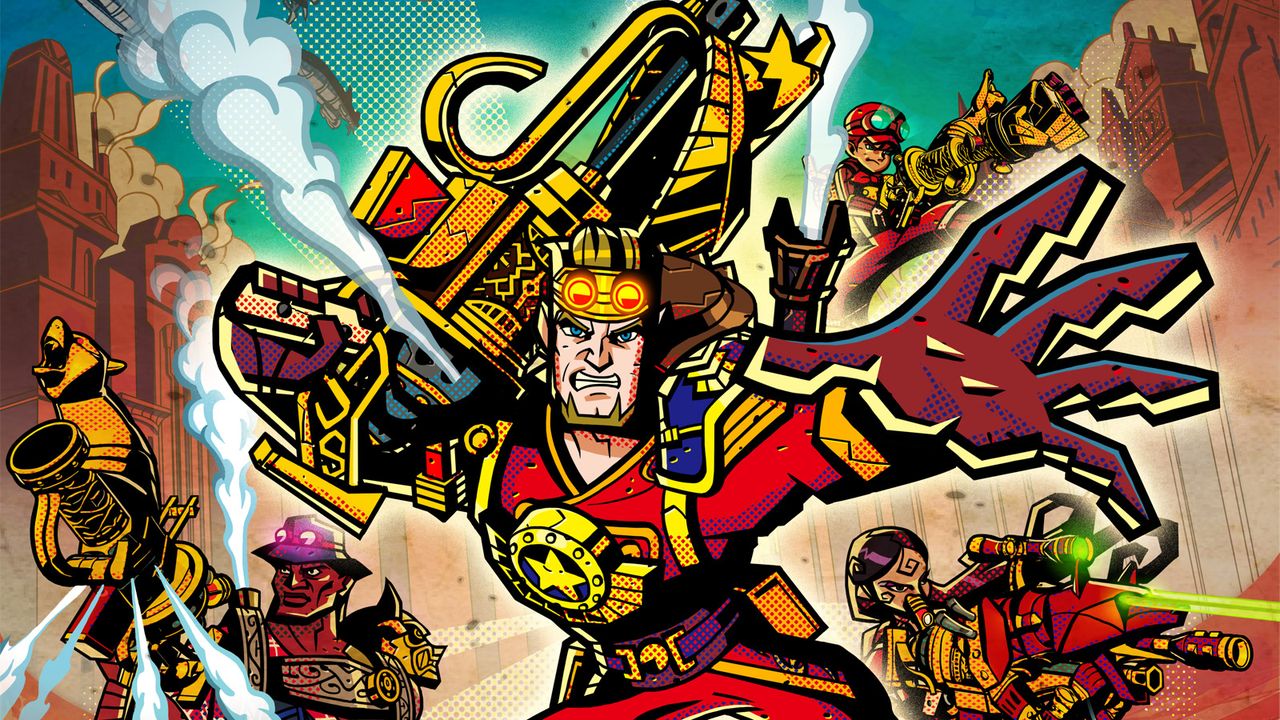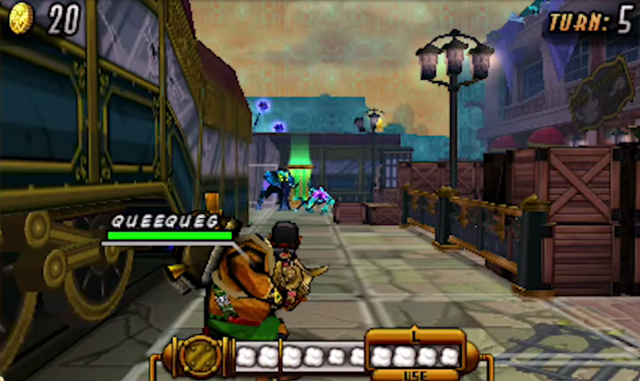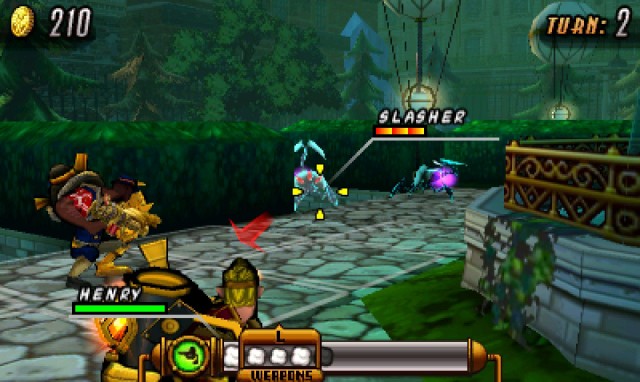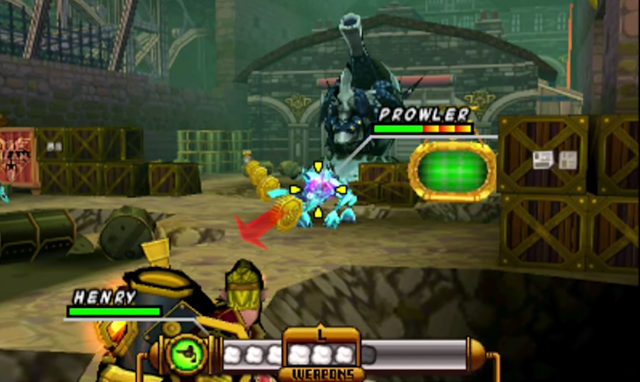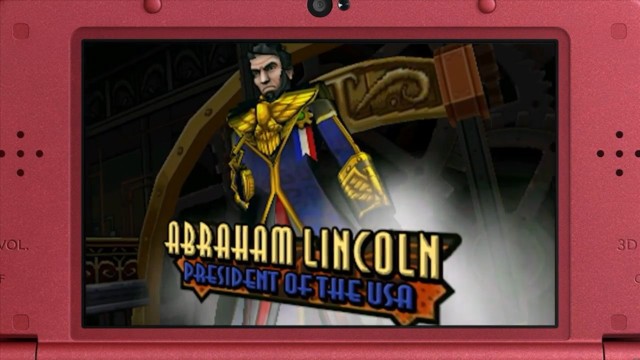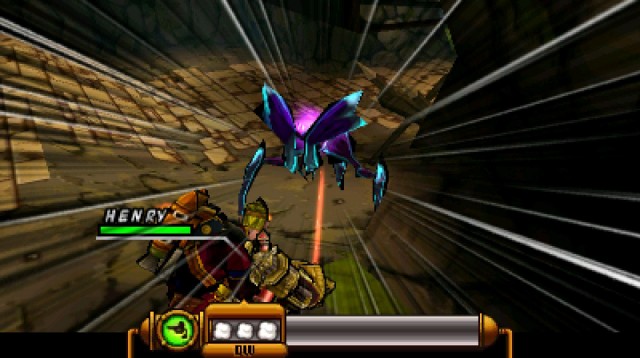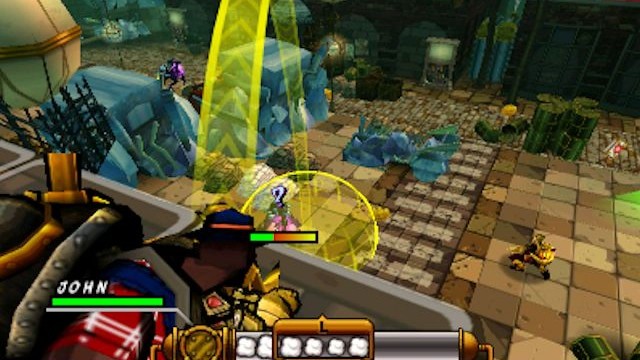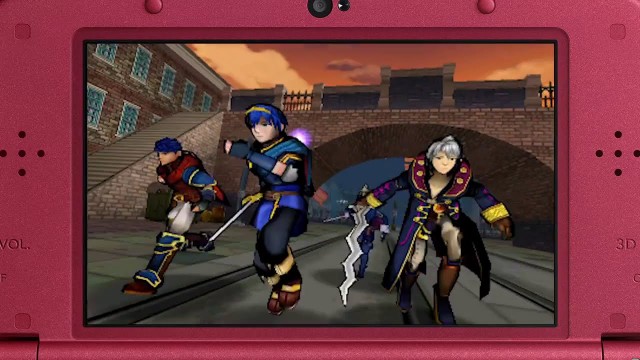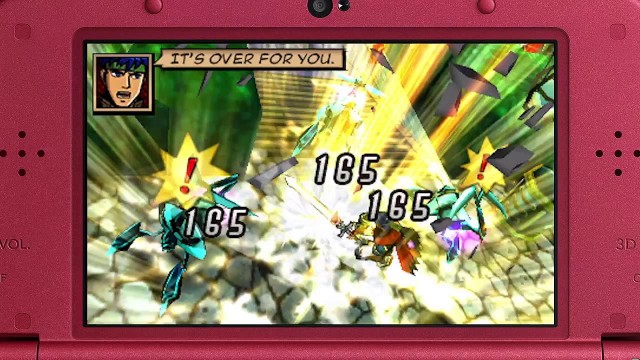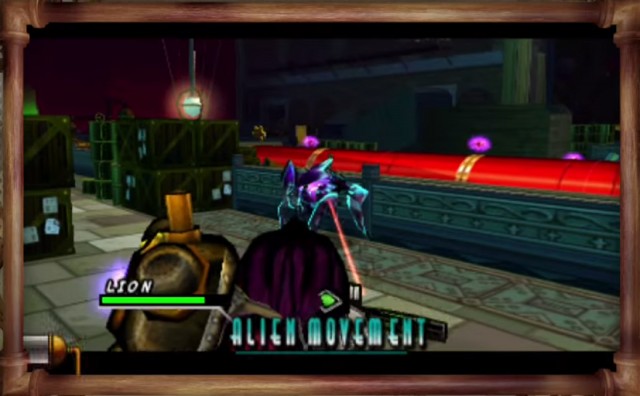Code Name S.T.E.A.M. is one of those games that makes you say to yourself, “Boy, the sequel to this would probably be awesome!” It’s a game where you can see tons of great ideas, and a world that feels undeniably cool to get immersed in, especially with the wind of that ever-lovable Nintendo charm at its back… Yet it’s also an experience that feels undeniably rough, with gameplay ideas that feel inspired, yet don’t necessarily gel together into a wholly enjoyable final product.
For those unfamiliar, Code Name S.T.E.A.M. is a Nintendo 3DS exclusive that comes straight from Nintendo, marking their other big new retail game IP to come this year, just over two months before Splatoon on Wii U. The game is developed by the Big N’s Fire Emblem and Advance Wars partner, Intelligent Systems, and as with those games, it’s a strategy game that uses its charming exterior to coat some surprisingly deep, highly challenging tactical gameplay. Code Name S.T.E.A.M. separates itself from the pack however by including third-person shooter-style combat that blends with the turn-based strategy foundation, inviting comparisons to similar genre mash-ups such as XCOM or Valkyria Chronicles.
Between its sky-high production values and desire to take advantage of the improved processing power and exclusive features offered by the New Nintendo 3DS (XL), Code Name S.T.E.A.M. is clearly a project that has had a big push behind it from Nintendo. That’s why it hurts to see the game fumble some really amazing ideas, being more of a chore to actually play than it really should be.
Enthusiastic strategy gamers that own a 3DS/2DS and are looking for a challenge will still want to check out Code Name S.T.E.A.M., which contains enough creativity and engagement to merit a playthrough from hardcore tacticians. The game isn’t all it could have been though, and you’ll definitely need to pack a lot of patience to get anything worthwhile out of the experience.
Code Name S.T.E.A.M. absolutely leaps off of the screen, and that’s not simply due to its potent 3D presentation! The game is absolutely gorgeous for the most part, and could very well be one of the most visually ambitious games in the entire 3DS library to date, packing an impressive steampunk world that marks yet more uncharted territory for the incredible range of backdrops within the Nintendo game catalogue.
The game’s art style borrows heavily from colourful, light-hearted Silver Age comic books, as in comics from the 1950’s and 1960’s, back during the time when comic books were wide-eyed kids’ stuff that was meant to be pure, silly popcorn entertainment, not the deep, philosophical and mature comic book stories that saturate the entertainment market today. This works wonderfully with Nintendo’s panache for creating what are often the industry’s most charming games, as comic book text is used to illustrate dialogue bubbles and big, vibrant onomatopoeias that punctuate the action. As far as presentation goes, Code Name S.T.E.A.M. is unprecedented for 3DS standards! Even the touch menus look absolutely amazing, unfolding as realistic-looking steampunk mechanical apparatuses that have you pressing pronounced old-school buttons or flicking a watch dial to make selections and announce a turn’s end.
For the most part, character models are also quite well-done, with each of the American literature/history-inspired heroes sporting lots of cel-shaded character and distinction. The game’s interpretations of beloved characters from stories like The Wizard of Oz and Moby Dick, among others, look very neat and well-detailed, particularly in how effectively it not only makes these highly distinct fictional characters operate together as an ersatz “Steampunk Avengers”, as it were, but also share a universe and conflict with real-life historical figures such as Abraham Lincoln. The only time that this great illusion falls apart however is with the opposing H.P. Lovecraft-inspired alien designs, which look too same-y and unremarkable for the most part. It’s not until later in the game that you see more noteworthy and impressive-looking aliens on a more regular basis, and even then, they don’t manage to go together with the more bright, cheery hero designs.
Code Name S.T.E.A.M. is at its most immersive and engrossing when the 3D Slider is cranked up as well. The game’s 3D presentation is exceptionally done, making environments stretch out realistically, and giving you a vastly improved sense of distance and proximity between enemies. This is very helpful when it comes to judging how likely you are to successfully target an enemy, or perhaps how close you are to alerting enemies, particularly those that can pick at you with dangerous Overwatch ambushes. It makes for an excellent use of 3D for both visual polish and gameplay, and playing in 3D definitely gives you a small, but notable strategic advantage in contrast to those opting to flick off the 3D Slider, or those who are playing on a 2DS. Even in 2D however, Code Name S.T.E.A.M. nonetheless remains a visual delight.
It’s too bad that most of your alien foes feel so heterogenous from the rest of the visual design, but beyond that small gripe, Code Name S.T.E.A.M. excellently demonstrates what the 3DS line of handhelds is visually capable of when it’s pushed to exciting new places!
Code Name S.T.E.A.M. may boast very colourful, Nintendo-approved graphics, but its audio definitely aims for intensity and edginess, save for an occasional title theme song called “Code Name T.H.E.M.E.” (har har), that feels corny, yet catchy enough to enjoy ironically.
Most of the music in Code Name S.T.E.A.M. consists of hard rock tunes, sometimes with a simulated air of grinding machinery, to help reinforce the environment. Only rarely does the soundtrack quiet down with a more understated, ambient track when you’re actually controlling it, particularly given the absurd amount of aliens that the game almost always surrounds your units with. It’s an acceptable suite of music, and it definitely fits when you’re on a roll of triumphant alien slaughter, though the relentless intensity of the music does feel more like it belongs in a straightforward action game, not a highly tactical strategy game of this nature.
Sound effects are an interesting blend between intense firepower and cartoon-ish artillery, almost like a softer spin on the kind of destructive audio you’d hear in games like Ratchet & Clank. Weapons definitely hit with quite a lot of punch, as do injuries sustained by alien attacks on your team, particularly if you’ve plugged in a pair of headphones. The music even helpfully quiets down (for once) when attacks are made by yourself or an enemy, allowing the game to really hammer home either the satisfaction or the pain behind the assault. Outside of battle, you’ll be greeted by a lot of buzzing steampunk machinery and hissing steam as you tap surprisingly detailed touch menus and the like, which come alive all the more when they respond so realistically to player input, as if they were really coming out of the Touch Screen.
As is a rarity for first-party Nintendo games, Code Name S.T.E.A.M. also supports full voice acting as well. The voice acting is quite good, if a little bit cheesy, and each character has tons of personality behind them, making it easy for players to identify with their favourite S.T.E.A.M. agents. Nintendo even authorized some Hollywood talent for the game to boot, with fan-favourite Star Trek: The Next Generation veteran, Wil Wheaton voicing Abraham Lincoln for example. This is quite possibly the very first time that Nintendo has hired recognizable Hollywood actors to provide voice work for one of their games, even if only a couple of them, and it’s a bit odd that a brand new, mostly un-advertised IP like Code Name S.T.E.A.M. would achieve that kind of milestone for the Big N, who still largely prefers to keep their marquee game franchises’ stories unvoiced.
Code Name S.T.E.A.M. deviates quite noticeably from Nintendo’s reliable audio playbook in some key respects, without completely escaping the realm of cartoon escapism that the company prides itself on within their games. That said, it’s quite possibly one of the most violent video games in Nintendo history (even if the violence is still quite fantastical), boasting a T-rating, and being among the elite few Nintendo games to earn one. It may still be a recognizable Nintendo experience, but it’s definitely one with a harder edge!
Code Name S.T.E.A.M. incorporates elements of a third-person shooter from an over-the-shoulder viewpoint, but at its core, it’s an uncompromising turn-based strategy game that demands patience, and often punishes even slight mistakes rather harshly.
The game is divided into a set of Chapters, as with pretty much any game by Intelligent Systems, and each chapter unfolds with anywhere from one to three battles within it. Each battle tasks players with an objective, whether it be reaching a goal point, eliminating all enemies, defeating a boss, or perhaps surviving a certain amount of turns. This is done with players and enemies taking turns to move their units around, try and attack foes, or perform support functions like healing or Steam boosts.
Steam is the backbone of your squadron as well, so you’ll definitely need to keep an eye on it! Every move you make consumes a certain amount of Steam, with players having a limited quantity of Steam to use in their Boilers on each turn, which are backpack-like tools that let them perform battle actions. Every step that a character takes consumes one cloud of Steam, though you can backtrack to undo steps if you simply want to scout ahead, or decide to re-place a unit. What you can’t undo however are attacks, which consume anywhere from two to four Steam clouds to perform, depending on their power and flexibility. Likewise, if you’re caught in a trap or an enemy Overwatch attack, or pick up a health-restoring Medkit, you’ll permanently lose the Steam you consumed, so step carefully! Fortunately though, running around to pick up Coins and Gears, collectibles that let you access better equipment, doesn’t permanently eat up Steam, allowing you to backtrack afterward and return to your battle strategy, so long as you’re not ambushed by enemy Overwatch tactics.
What is Overwatch, you ask? Well, it’s a way to spice up gameplay beyond the basics of turn-based strategy combat. If you leave the required amount of Steam in a unit’s boiler by not expending it moving and/or attacking on a given turn, you can point that unit’s target reticule in a certain direction, then end the turn, which activates Overwatch for the Enemy Phase. If an enemy wanders into that unit’s sights, your unit will then attack them with an ambush using whichever weapon they’ve equipped (be advised that some weapons don’t allow for Overwatch), damaging them, and potentially even knocking them away, or even stunning them to render them useless for the rest of the enemy’s turn! Bear in mind however that your enemies can use Overwatch attacks as well, and they’re not limited by Steam. Don’t step carelessly, and always pay attention to your surroundings!
Herein lies the first of Code Name S.T.E.A.M.’s issues though. Since there’s no overhead view, and players are limited to viewing everything from over their units’ shoulders, it really hurts your ability to navigate the battlefield. You have to move your units very slowly to avoid being caught in Overwatch attacks or other such traps, especially when virtually every battle in the game has you heavily outnumbered, particularly in restricting you to just four units per battle. Maps are beautifully detailed, that’s true, but this also means that they’re full of obstructions and blind corners, and trying to account for enemies potentially being around every corner doesn’t make battles more exciting. Instead, it makes them more slow-paced and tedious, which is one of the key reasons why Code Name S.T.E.A.M. demands quite a lot of patience from the player.
The other reason why players will need to be patient with the game is its difficulty and learning curve, both of which are quite high. Code Name S.T.E.A.M. doesn’t have adjustable difficulty either, and seems to be explicitly designed for skilled strategy gamers that actively want a challenge. Those people will certainly get a worthy test of their skills, though sometimes for the wrong reasons. Most battles in Code Name S.T.E.A.M. are well-designed in theory, though the constant disadvantage that the player is at, the harsh punishments for even small slip-ups, and the A.I. knowing the lay of the land when the player doesn’t, sometimes results in frustration more than it does fun.
Fortunately, if you’re diligent with amassing Coins and Gears, you can at least outfit your units with better equipment, which helps to give them a slightly increased fighting chance. Coins allow the S.T.E.A.M. agency to buy new sub-weapons, which units can swap between alongside their unchangeable main weapon, and which can perform a variety of offensive and support functions that can help use spare Steam to turn the tide of battle. Likewise, Gears allow you to gradually unlock specialized Boilers, divided into Light, Medium and Heavy classes, depending on the size of the unit carrying them. Different Boilers allow you to potentially hold and charge more Steam between turns, as well as allowing for other things like the ability to scale walls, double damage when you hit enemy weak points, or perhaps grant bonuses to a unit’s innate offensive and defensive stats.
Outfitting your team is only half the necessary preparation though. Deciding which four units to bring in to battle is also crucial. Managing a smaller group of S.T.E.A.M. agents may mean less active units to keep track of in each battle, though it also means that you’ll need to make the most of each unit’s specialties to get through the battle, since enemies will always heavily outnumber you. Some units have more health than others for example, while some can move around easier, or have better attack power or range. Every unit also has their own unique special attack that you can activate on the Touch Screen once per battle, which gives you any number of creative trump cards with which to try and turn around a disadvantage when you’re in a tight spot.
That’s before you consider the unique main weapon that each unit wields as well. When you start the game with lead character, Henry Fleming, you’ll merely have an ordinary rifle to shoot with. Soon after however, you’ll meet characters like Tom Sawyer, who uses a ‘Punch Gun’ that both damages enemies and knocks them backward, or Queequeg, whose main weapon aims a roving robotic penguin that explodes upon contact with any surface or enemy. Unit distinction in the game is quite well-done, with no unit feeling useless or superfluous in the grand scheme of things. Each battle gives you more than one way to approach it, thanks to the great diversity behind the units you can bring in to suit your play style, even if that heavy hand of punishment for gameplay mistakes is still an issue that hurts some of the value of experimentation with your squad.
Even if it’s mainly a strategy game, Code Name S.T.E.A.M. demands quite a bit of shooting precision if you want to succeed as well. You’ll have the best time in fights if you’re able to aim well and make tricky shots to enemy weak points and vulnerable environmental obstructions, which is thankfully easier when you have all the time in the world to aim in place, thanks to the turn-based combat style. Some units use mortar-style attacks that have you aiming an arc and positioning a blast radius, though even this requires careful planning to maximize attack potential, and avoid damaging your own units accidentally.
This demand is best met on New 3DS (XL) handhelds as well, where the C-Stick unique to those handhelds proves to be a godsend in a game with this kind of shooting mechanics. With the C-Stick, you can just nudge your finger along the nub to aim the reticule with far greater precision and comfort, which is a big advantage to playing Code Name S.T.E.A.M. on a New 3DS (XL). You can use a Circle Pad Pro as a second stick on a launch model 3DS as well, but the game isn’t optimized for it, and frankly, it feels rather clunky. If you don’t have a New 3DS (XL), you’re limited to either trying to move the reticule with the X, Y, B and A Buttons, or trying to steer it using the stylus on the Touch Screen, and neither method feels very ideal, even if the supposedly oddball placement of shooting with the L Button makes sense with this control setup. Aiming is certainly not impossible on an original 3DS (XL) or 2DS, but it’s less intuitive, and it does make battles more time-consuming than they would be with the more precise and reliable aiming offered by the C-Stick on the New 3DS (XL) models.
The other big incentive to play Code Name S.T.E.A.M. on a New 3DS (XL) handheld is the built-in Amiibo support, which allows you to scan the four Fire Emblem series Amiibo from the Super Smash Bros. set, namely Marth, Ike, Robin and Lucina, to add those characters to your squad, complete with their fantasy-themed weaponry. If the unit falls in battle, you’ll need to scan the Amiibo again to use them in another battle.
This functionality is a great idea, and a wonderful use of Amiibo, particularly since, while each of the four Fire Emblem characters are effectively distinct both amongst each other and the normal in-game units, none of them are game-breaking additions. They just give you a neat new way for Nintendo fans, and especially fans of Intelligent Systems, to play Code Name S.T.E.A.M. That’s why it’s so infuriating that the Fire Emblem Amiibo characters are so stupid rare in the West, and never in stock at any retailers, meaning that most players of Code Name S.T.E.A.M. won’t be able to access this feature at all, since they won’t be able to find the compatible figures without resorting to scalpers, or praying for one of those five-minute online retailer restocks. Seriously, Nintendo, you’ve got to get your act together with this Amiibo thing! There’s no point putting cool features like adding Fire Emblem characters to your S.T.E.A.M. squad in Code Name S.T.E.A.M., if people can’t get ahold of the right figures without importing from other regions, or having to break the bank paying exorbitant scalping prices! That’s before considering that, at this point anyway, you need a New 3DS (XL) to use Amiibo in the game to begin with!
Anyway, the Fire Emblem characters are limited to use in the main story, though that’s not the only mode of play you can enjoy in Code Name S.T.E.A.M. The game allows you to share StreetPass scores to try and earn the highest mission rankings for small, but inconsequential bonuses, to start. It’s an acceptable use of StreetPass, though given the lacklustre sales of Code Name S.T.E.A.M., you’ll probably be hard-pressed to find people to share scores with in your community.
Fortunately though, there is a dedicated multiplayer mode in Code Name S.T.E.A.M., allowing you to play head-to-head matches with your units both locally against friends, and online against players from around the world. After choosing squads of four, players will find a slight alteration in that, unlike the main single-player campaign, they now have only sixty seconds to move their units and attack per turn. This creates a kind of speedy intensity that gives the multiplayer its own effective challenge factor. Avid tacticians will love facing off against online opponents and seeing whose strategies dominate, particularly when you can use any players and equipment you’ve attained in the main single-player campaign. Nintendo even hosts regular tournaments for online players, which is awesome, and further disappointing when one recalls that Code Name S.T.E.A.M. wasn’t a big seller in any region.
Aside from taking on players in simple elimination rounds where you take out the enemy team before they take out yours, you can also compete over a series of five turns to amass the most Medals, rewarded for accomplishing tasks in combat. There’s also A.B.E. Battle, which puts players in control of a giant Abraham Lincoln-like mech, something that also occasionally comes up in the main single-player campaign. Honestly though, the A.B.E. mechanics are a real bust, feeling clunky and unintuitive, meaning that this multiplayer mode is the one that players are best off ignoring. Even during the A.B.E. Battles in the single-player campaign, they’re unrewarding and over far too quickly, and they’re the one point where Code Name S.T.E.A.M. goes from being annoyingly punishing to laughably easy, changing its hardcore tactical gameplay to a hamstrung, brainless version of an action game. The fact that the game’s final boss is taken on in an A.B.E. Battle only adds more insult to injury there.
Given the wealth of great ideas in Code Name S.T.E.A.M., it’s heartbreaking to see the game come up short in some of the surprising ways it does. The small player base isn’t something you can necessarily blame the game for, but the fact that its main single-player gameplay is so slow-paced and punishing, and its environmental setup is so unhelpful when planning your attack strategy, is a pretty big problem. When Code Name S.T.E.A.M. gets in a groove, its gameplay works really well, and gives a clever complement to the likes of Fire Emblem and Advance Wars before it, but when it stumbles, it brings its momentum to a screeching halt as you bang your head against the wall in the face of frustration and sluggish, dogged combat. Pair that with Amiibo features that will be inaccessible to most players, and aiming that is a lot less intuitive without the C-Stick of the New 3DS (XL), and you have a game that is rough in design, even if it’s mind-blowing in production values.
At least Nintendo patched in the ability to speed up the agonizingly long Enemy Phases shortly after this game’s launch though. That’s appreciated!
Code Name S.T.E.A.M. spins a tale of all-American silliness, making it pretty evident that Intelligent Systems was trying to design a 3DS game that largely appealed to the West most of all. It’s not a complex story, or even a terribly smart one, checking off the same tired alien invasion tropes, which only set themselves apart to a point on account of the many characters from American history and folklore being the protagonists, and unfolding everything within the game’s colourful and unique steampunk atmosphere.
Code Name S.T.E.A.M. is supposed to be silly to a point, simply unfolding as not-actually-dead president, Abraham Lincoln secretly forms the titular S.T.E.A.M. force (with S.T.E.A.M. standing for ‘Strike Team Eliminating the Alien Menace’), in response to aliens overrunning and gradually freezing over the planet. It’s the kind of thing that would feel at home during the ridiculous Silver Age of comic books, though this doesn’t exactly create a compelling plot to help push you through the considerable slogs of the gameplay.
As much as Code Name S.T.E.A.M. has plenty of cutscenes, all fully voice-acted to boot, its personalities never expand beyond being upbeat saviours of humanity, and its story never really gives any added meaning to what amounts to a pretty shallow alien attack conflict. The game no doubt wasn’t trying to be taken seriously, but even if it’s got its tongue planted in its cheek, that doesn’t excuse the game’s personalities feeling so under-developed, nor its world and lore feeling so shallow.
Code Name S.T.E.A.M. feels like a foundation of outstanding ideas that make for a shakier whole than they should. The game is still good for those who really enjoy hardcore strategy gaming, but it’s too punishing and tactical to merit interest for those looking for a dedicated shooter, and general Nintendo enthusiasts will probably be put off by the heavily slow, overwrought pace of the gameplay. Frankly, the limited appeal of Code Name S.T.E.A.M. is really a problem, especially for a game that Nintendo clearly wanted to groom as a big new 3DS IP, as evidenced by its mere announcement getting its own E3 2014 Roundtable.
So, if you fall outside of the die-hard tactician crowd that adores Intelligent Systems and wants to cut their teeth on a brand new degree of gameplay and challenge, Code Name S.T.E.A.M. probably isn’t for you, and that’s a real shame. It’s a gorgeous game that’s extremely well-presented and packed with lots of charm, but none of that amounts to much when the gameplay backbone too often fails to be fun. Considering that the 3DS has enjoyed several other great exclusives this year already, and only has more highly promising known exclusives coming in late 2015 and early 2016, Code Name S.T.E.A.M. has even less of a leg to stand on.
There’s a lot of effort behind Code Name S.T.E.A.M., and it’s a game with the best of intentions, but in the end, it wouldn’t be completely wrong to declare it a failed experiment. Like I said though, it’s the kind of game that does tap into a lot of promise, and a sequel with some key refinements could definitely help this new IP achieve its potential, and stand alongside Fire Emblem and Advance Wars as more of the creme de la creme strategy gameplay that Intelligent Systems often has such a knack for. With more flexible battlefield viewpoints, adjustable difficulty, and a deeper, more memorable storyline, this idea could indeed become the next must-have 3DS blockbuster.
For now though, what we’re left with is a lot of heart, but also a lot of lost potential. A for effort, Intelligent Systems, but if S.T.E.A.M. is ever to assemble again, it might be better if you loosened up and focused more on making the gameplay as entertaining as the presentation.

